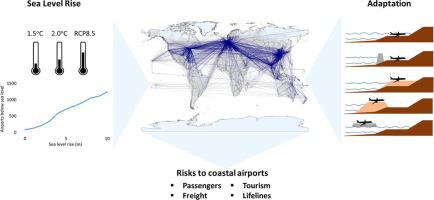当前位置:
X-MOL 学术
›
Clim. Risk Manag.
›
论文详情
Our official English website, www.x-mol.net, welcomes your
feedback! (Note: you will need to create a separate account there.)
Global analysis of sea level rise risk to airports
Climate Risk Management ( IF 4.8 ) Pub Date : 2020-12-31 , DOI: 10.1016/j.crm.2020.100266 Aaron N. Yesudian , Richard J. Dawson
Climate Risk Management ( IF 4.8 ) Pub Date : 2020-12-31 , DOI: 10.1016/j.crm.2020.100266 Aaron N. Yesudian , Richard J. Dawson

|
Major airports are already at risk of coastal flooding. Sea level rise associated with a global mean temperature rise of 2 °C would place 100 airports below mean sea level, whilst 1238 airports are in the Low Elevation Coastal Zone. A global analysis has assessed the risk to airports in terms of expected annual disruption to routes. The method integrates globally available data of airport location, flight routes, extreme water levels, standards of flood protection and scenarios of sea level rise. Globally, the risk of disruption could increase by a factor of 17–69 by 2100, depending on the rate of sea level rise. A large number of airports are at risk in Europe, Norther American and Oceania, but risks are highest in Southeast and East Asia. These coastal airports are disproportionately important to the global airline network, by 2100 between 10 and 20% of all routes are at risk of disruption. Sea level rise therefore poses a systemic risk to global passenger and freight movements. Airports already benefit from substantial flood protection that reduces present risk by a factor of 23. To maintain risk in 2100 at current levels could cost up to $57BN. Although the cost of protecting larger airports is higher, busier airports are typically well protected and more likely to have better access to adaptation finance. However, 995 coastal airports operate 5 commercial routes or fewer. More detailed consideration of these airports shows that regions, especially low lying islands, will experience disproportionate impacts because airports can provide important economic, social, and medical lifelines. Route disruption was used as the risk metric due to its global coverage and relationship with direct economic impacts. Further work should collate a wider range of impact metrics that reflect the criticality of an airport in terms of the isolation and socio-economic context of the location it serves.
中文翻译:

全球海平面上升对机场的风险分析
主要机场已经面临沿海洪水的风险。全球平均气温上升 2°C 导致的海平面上升将使 100 个机场低于平均海平面,而 1238 个机场位于低海拔沿海地区。一项全球分析评估了机场每年预计航线中断的风险。该方法整合了全球可用的机场位置、飞行路线、极端水位、防洪标准和海平面上升情景的数据。在全球范围内,到 2100 年,破坏的风险可能会增加 17-69 倍,具体取决于海平面上升的速度。欧洲、北美和大洋洲的大量机场面临风险,但东南亚和东亚的风险最高。这些沿海机场对于全球航空网络来说异常重要,到 2100 年,所有航线中的 10% 至 20% 面临中断的风险。因此,海平面上升对全球客运和货运构成系统性风险。机场已经受益于大量的防洪措施,可将当前风险降低 23 倍。要在 2100 年将风险维持在当前水平,可能需要花费高达 570 亿美元。尽管保护较大机场的成本较高,但较繁忙的机场通常受到良好保护,并且更有可能获得更好的适应融资。然而,995 个沿海机场运营 5 条或更少的商业航线。对这些机场的更详细考虑表明,地区,特别是低洼岛屿,将遭受不成比例的影响,因为机场可以提供重要的经济、社会和医疗生命线。由于路线中断的全球覆盖范围以及与直接经济影响的关系,路线中断被用作风险指标。 进一步的工作应该整理更广泛的影响指标,以反映机场在其服务地点的孤立性和社会经济背景方面的重要性。
更新日期:2020-12-31
中文翻译:

全球海平面上升对机场的风险分析
主要机场已经面临沿海洪水的风险。全球平均气温上升 2°C 导致的海平面上升将使 100 个机场低于平均海平面,而 1238 个机场位于低海拔沿海地区。一项全球分析评估了机场每年预计航线中断的风险。该方法整合了全球可用的机场位置、飞行路线、极端水位、防洪标准和海平面上升情景的数据。在全球范围内,到 2100 年,破坏的风险可能会增加 17-69 倍,具体取决于海平面上升的速度。欧洲、北美和大洋洲的大量机场面临风险,但东南亚和东亚的风险最高。这些沿海机场对于全球航空网络来说异常重要,到 2100 年,所有航线中的 10% 至 20% 面临中断的风险。因此,海平面上升对全球客运和货运构成系统性风险。机场已经受益于大量的防洪措施,可将当前风险降低 23 倍。要在 2100 年将风险维持在当前水平,可能需要花费高达 570 亿美元。尽管保护较大机场的成本较高,但较繁忙的机场通常受到良好保护,并且更有可能获得更好的适应融资。然而,995 个沿海机场运营 5 条或更少的商业航线。对这些机场的更详细考虑表明,地区,特别是低洼岛屿,将遭受不成比例的影响,因为机场可以提供重要的经济、社会和医疗生命线。由于路线中断的全球覆盖范围以及与直接经济影响的关系,路线中断被用作风险指标。 进一步的工作应该整理更广泛的影响指标,以反映机场在其服务地点的孤立性和社会经济背景方面的重要性。









































 京公网安备 11010802027423号
京公网安备 11010802027423号